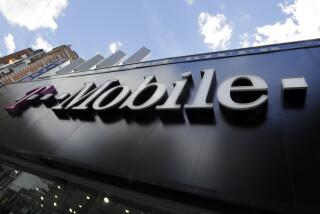Getting a Bad Connection on Long-Distance Service
- Share via
Question: Like everybody else in California (I guess), I am being flooded with mail from not only the telephone company, but every long-distance service in the country, trying to get me to “vote” on which long-distance service I want. Nobody, however, is very specific about when I have to do this voting.
Also, I’ve enclosed a mailing I just received from AT&T; that makes me wonder if the competitive scramble to sign everyone up isn’t moving into the realm of “dirty tricks.”
You’ll notice, first, that the letter congratulates me “for selecting AT&T; as your long- distance company,” and continues with this strange insertion: “This letter confirms the following information concerning your choice: Acknowledgment of AT&T; selection on September 20, 1985 for telephone No. XXX. We are notifying your local telephone company that you have selected AT&T.; In order to prevent any possible confusion about your order and to ensure uninterrupted easy access to AT&T; Long-Distance service, we also need to obtain your written authorization. Therefore, please sign and return the attached AT&T; Long-Distance Authorization Form as soon as possible.”
And then, at the bottom of the letter, there’s a tear-off form with a big black check mark in a box headed: “YES, I want AT&T; to provide my long-distance service.”
What makes this all so strange is the fact that, a month or two ago, we definitely sent back a form choosing MCI for our long-distance service, not AT&T.; So, what’s all this business about choosing AT&T; on Sept. 20 when we did no such thing?
This looks like a deliberate attempt on AT&T;’s part to confuse us and to cancel out our previous selection of MCI. What other explanation could there be?--J.F.C.
Answer: Confusion is, indeed, very much the name of the game as the wonderful world of deregulation falls, raggedly, into place.
And it’s compounded because this type of deregulation--after more than 100 years of AT&T;’s virtual monopoly--is so strange to us. The idea of “shopping” for telephone service is still as foreign as shopping around for an alternative water company.
Not helping on the confusion front, either, is the fact that this is a laborious, ongoing operation that can proceed only as fast as Pacific Bell and General Telephone switch over to all-new electronic equipment, and so there is no clear-cut way of telling exactly when your community (or prefix number) is switching over to “equal access” service--except by the volume of mail you begin receiving trying to sell you on this long-distance service in preference to that long-distance service. Once this volume accelerates it normally means that you are within 90 days of making the switch-over.
As far as Pacific Bell is concerned, however, the conversion began in December, 1983, but the emphasis both this year and next is concentrated on the Greater Los Angeles area, according to media spokesman Larry Mobbs. By the fall of ‘86, however, about 75% of Pacific Bell’s customers statewide--and that translates to about 7 million telephone users--will be on equal access. And the proportion in Los Angels County will be much higher than that.
As the current year winds down, according to GTE public affairs director Tom Leweck, about 11% of their customers will be on equal access, but the big push will come in ’86 with 78 conversions (of communities and prefixes) scheduled that will sweep about 51% of GTE’s customers into the fold. By the end of ‘87, more than 90% of its customers will have equal access.
“I’ll admit that it’s pretty confusing for the customers,” Leweck added, “but they certainly shouldn’t be intimidated by it because it’s a definite plus for them. Not only will they have to dial only one number to call long distance, but because of the new electronic equipment required, both the reception and the service, generally, should be better.”
And the rhubarb about which long-distance service to choose shouldn’t be all that intimidating, either, Leweck said. “It’s not like a marriage, you know. You can change services anytime you want to--there’s fee of about $5.” And, during the honeymoon period--after you’ve gone to equal access--you can, literally, shop around trying the various services and seeing how you like them.
Even after you’ve zeroed in on one long-distance company, he continued, there is still a provision for the “casual user.” This means that even though you’ve signed up for, say, MCI, if GTE Sprint has a temporary “special” for certain parts of the country, then GTE Sprint will accept your call even though it isn’t your primary service.
Generally speaking, according to the state of California’s Department of Consumer Affairs, unless you habitually chalk up at least $15 a month in long-distance calls, one service may not represent much savings, if any, over another. But, above $15 a month, it definitely pays to shop around and run some comparisons--particularly as far as rates between your home and the cities you most frequently call are concerned.
But here are some other considerations to be weighed: the rate difference between the various services for calls billed to your telephone number and those placed on a person-to-person basis; what about installation or start-up fees, the monthly service charge, the minium-use charge?
Does the company round off each call to the next full minute, half minute or six-second interval? Does the company offer time-of-day discounts, volume discounts, bonuses? How are disputed charges handled?
Does the company charge for busy signals, wrong numbers, bad connections, unanswered calls? Is there a long-distance directory-assistance charge? Can you call the company’s customer-service department at any time? How are bills charged to your number when you are traveling or away from home?
These--plus a valuable question-and-answer section and a brief history of how all this deregulation came about--are all included in a fine, 14-page booklet just published by the state: “Choosing a Long Distance Telephone Company Under Equal Access.” This is available without charge, but include a self-addressed, stamped (39 postage), legal-size (No. 10) envelope and write to: Equal Access Booklet, Department of Consumer Affairs, P.O. Box 310, Sacramento, Calif. 95802.
But, now, what about the sly trick (as you see it) that AT&T; tried to pull on you?
Well, honor bright, there’s nothing sinister in it, Rich Burk, AT&T;’s director of carrier selection in the 12 western states, assures us. Nor is there cause for you to worry about that phrase: “We are notifying your local telephone company that you have selected AT&T.;” Such notification, actually, isn’t really made until the authorization form is received, so there’s no chance that your earlier authorization choosing MCI has been canceled out. Not to worry.
Some letters like yours, Burk concedes, did indeed go out in error, “but I don’t have any specifics on them, and I doubt very much if they amount to more than one-tenth of 1% of the total. When you have an endeavor with this sort of mass, there are going to be a few glitches, and I doubt very much if it’s unique with us.”
In just June, July and August, he adds, AT&T; sent out no fewer than 3 million mailings to residential telephone users in California alone, and it would be something of a miracle if a few of them didn’t get fouled up.
“Starting today,” Burk says, “we’re making an effort to contact everyone who got one of these erroneous letters in order to apologize to them and to assure them that if they’ve already sent in authorization for another service, nothing’s been changed.”
Don G. Campbell cannot answer mail personally but will respond in this column to consumer questions of general interest. Write to Consumer VIEWS, You section, The Times, Times Mirror Square, Los Angeles 90053.


